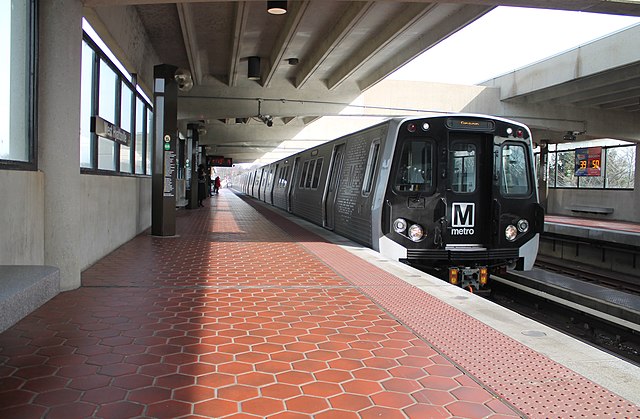A recent staff presentation to the Washington Metro board’s finance committee revealed that the agency is expecting to run out of federal COVID relief funds in 2024 and anticipates a $187.5 million shortfall in funding that year. From then on, it anticipates funding shortfalls of more than $500 million a year, rising to more than $700 million by 2030.
With half of DC employees working at home, Washington Metro trains have been running nearly empty since the pandemic began. Photo by Elvert Barnes.
That’s if ridership recovers to 100 percent of pre-pandemic levels. If only 75 percent of riders return, shortfalls will range from more than $700 million in 2025 to more than $900 million in 2030. In fact, as of July, ridership was still less than 50 percent of pre-pandemic numbers.
The Washington Post has portrayed this as “not as grim as first predicted,” partly because “ridership has outpaced expectations.” The agency previously projected it would have a $350 million shortfall in 2024. I suspect the reason for the decline was not increased ridership but a reduction in service that was forced on the agency for safety reasons.
According to its 2021 financial statement, Metro’s operating revenues (mainly fares) declined from $790 million in 2019 to $146 million in 2021, an 82 percent drop. To help make up for this, Metro received more than $1.6 billion of the $70 billion in COVID relief funds that Congress lavished on the transit industry, including $876 million in May 2020, $610 million in December 2020, and $120 million in March, 2021.
Even though ridership was well below pre-pandemic levels, the agency elected to squander that money by maintaining service during the pandemic. It spent 99.7 percent as much operating buses and trains in 2021 as it did in 2019.
In recent months, however, service has been only 70 percent of pre-pandemic levels. This was because half of its fleet of railcars was taken out of service due to frequent derailments. This probably did more to save the agency money than increased ridership.
To close its 2023 budget gap, Metro is basically crossing its fingers and hoping for the best. Its strategies include increasing ridership to 70 percent of pre-pandemic levels, increasing advertising and real estate revenues, and reducing expenses through “operating efficiencies” and “vacancy reductions.” None of these are likely to happen but even if they did they would cover only 22 percent of the shortfall. For the rest, Metro is looking to “increase current subsidies.”
The real problem is that Metro and its board are operating in a fantasy world where no one has to account for costs or the relationship of revenues to expenses. Instead, they simply keep on doing what they were doing as if the pandemic never happened, ignoring the fact that the agency never had a real safety culture or that its funding was never sustainable. Who cares about costs when Uncle Sam will bail out the agency if the alternative is for it to stop running those precious but nearly empty trains?
“I know that it is the Socialist idea that making profits is a vice,” said Churchill in 1937. “I consider that the real vice is making losses.” The nation’s transit industry in general and Metro in particular are an example of this vice.









Someone has a solution …
IN A CHEERFULLY animated promotional video, a woman narrates Cubic Transportation Systems’ vision for the future. Travelers will pay fares using a ticket-free mobile account. Real-time data will be aggregated, linked, and shared. Deals — such as 50 percent off at a partner coffee shop — may even incentivize users to select certain transit routes at certain times.
“The more information that is gathered, the more powerful the system becomes,” the narrator tells us. “The piece of the puzzle missing … is you.”
This is “NextCity,” Cubic Transportation Systems’ idea of a smart city: an urban area that uses technology and networked data to optimize functioning and mobility.
https://theintercept.com/2022/10/03/cubic-military-public-transit-mta-omny/
Of course, the system will not be used to eliminate “loss making” operations.
John Hammond syndrome…… spared no expense.